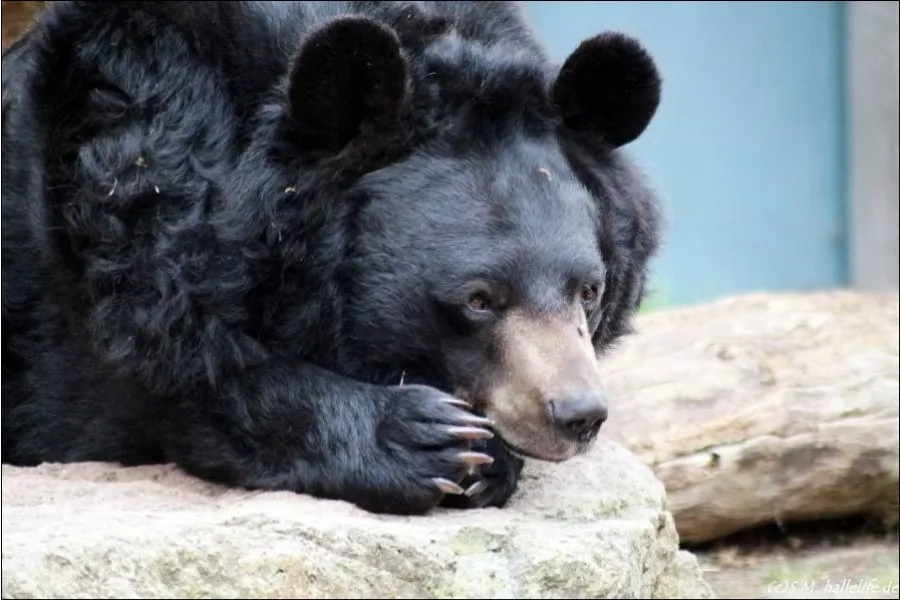
If you have ever been to a zoo, a park, or even seen a bear in the wild minding their own business, you might have seen them sitting and staring, and it seems to look like they show apathetic behavior and forms of depression.
It’s common for bears both in captivity and the wild to sit and stare blankly into space. Some believe that bears have the ability to absorb nature in another way than humans. However, there are cases reported with bears in captivity who suffer from apathy and depression.
If you see a bear in the wild sitting and staring into space, they might show they are uninterested in you. The bear might also show their disinterest in you by yawning. If you continue to approach the bear, you will agitate it, and the yawning will turn into growling and drooling.
Are bears self-aware?
Scientists have identified bears are self-aware in various ways. Bears seeing their own reflection in water have shown self-awareness and recognized themselves. There are also cases where grizzly bears had removed their own tracks and concealed themselves in trees and rocks when hunting. This behavior has helped biologists to know bears even have forethought.
What do bears think about?
Like all other animals, bears think about the same things. What they are going to eat, relationships with other bears, and worry about things. It has shown bears are highly intelligent animals, and many zookeepers and animal trainers say bears are more intelligent than dogs. Since bears are self-aware, they are able to express and feel other bears’ emotions. However, no one can explain what another being is thinking about – including humans.
Do bears have emotions and feelings?
Bears express their emotions and feelings to other bears already in their early childhood. Bear cubs play all day long by wrestling and chasing each other. Bears communicate through their body language, sound, and smells. Different expressions mean different things, and while a particular sound can express sadness, another can express happiness. It has been shown that bears have empathy and consciousness for other animals and can sometimes be altruistic. Bears communicate with other bears by standing on two legs, rubbing their backs to trees, and marking them with their scent.
Adult male bears usually live in solitude and don’t live in groups of families or groups – they can co-exist close to other bears and animals. However, there are examples of adult bears being mentors and role models to younger unrelated bears. It has also shown bears can build alliances and friendships with other bears.
How fast can bears run? Check our comparison list.

Are bears living in zoos depressed?
Most of us have spent the last two years in lockdown. Not able to go wherever we want or do whatever we please. Imagine removing all things stimulating your brain during that time. Your phone, your laptop, your tablet, your TV, and the Internet. Left are you, with some grey concrete walls. Doesn’t sound too appealing. Imagine now to live your entire life that way. Would you be depressed?
There are multiple examples of bears and other animals living in captivity that show forms of depression. In the wild, bears travel about 95 miles (153km) per year. Polar bears walk 20 miles (30km) per day. In zoos’ they are restricted to 1000 ft² (9km²). In the wild, a male bear’s habitat is between 100km² to 500km². Female bears’ habitats are between 20km² to 300km².
The saddest thing about bears raised in captivity is that they will never be released into the wild. The argument is that bears and other animals in captivity don’t know how to care for themselves and not rely on humans for food and shelter.
The argument is to preserve the species by isolating it from harm and try to breed as many younglings as possible from it in order to increase the number of animals in that species. That would be fine, as long as they are presented and raised in their natural habitat from the start. However, animals aren’t raised in their natural habitat. They aren’t increasing in numbers at the zoo, and if they were, they aren’t granted a larger area to live on. Instead, healthy animals are killed to make room for the new generation or even more popular species.
Note: Not all zoos work in this way, and some few don’t run zoos to make a profit – but instead aim to help endangered species.
🐻 Why Do Bears Walk Into Town?
How can you help bears?
Grizzly bears are since 1975 still classified as threatened and are excluded from hunting. There are around than 1,500 grizzlies in the lower 48 states and most of the grizzlies live in North America, and in Alaska in particular. It’s illegal to harm, harass and kill the grizzly. The only exceptions are self-defense.
Here are five tips on how you can help bears:
1. Support wildlife charities.
Thankfully there are some people out there who dedicate their lives in helping the bears.
Some charities worth mentioning are:
American Bear Association Vince Shute Wildlife Sanctuary
The sanctuary is Vince Shutes legacy to the future generation where the mission is to educate humans how to coexist with bears. Their missions are to protect the wildlife and various habitats found in the Vince Shute Wildlife Sanctuary. To facilitate the education of the public regarding black bears and the environment and to encourage non-invasive research in order to better understand black bears and their role in the environment.
Read more here.
Vital Ground Foundation
Vital Ground Foundations’ mission is to protect and restore North America’s grizzly bear populations for future generations. They are based in Missoula, Montana, and have the vision of a permanently connected landscape that ensures the long-term survival of grizzlies and the native species that share their range.
Read more here.
Polar Bears International
If your heart pounds more for the polar bears, Polar Bears International might be the organization for you. Their mission is to ensure the polar bear’s long-term survival and with multiple transparent strategic objectives, they are working towards that.
Read more here.
Great Bear Foundation
The Great Bear Foundation was created in 1981 and they are dedicated to the conservation of bears and their habitat around the world. Their goal is to educate humans on how we can coexist with bears and learn humans how to adapt.
Read more here.
Free The Bears
Free The Bears is an organization dedicated to rescuing bears that are close to extinction and putting them into their sanctuaries. Their sanctuaries are in Laos, Cambodia, and Vietnam. Their work increases every year due to the increasing illegal wildlife trade.
Read more here.
2. Be safe when driving your car.
Traffic accidents are one of the many reasons multiple bears and other animals are killed every year. When you are driving near the forest, make sure to be extra aware of animals running from the sides. Decreasing your speed a tiny bit can save the life of someone.
3. Be Bear-Aware When Hiking
If you are hiking in bear country there are some things to be aware of and things to consider.
1. Tell someone before you go out.
If you are going out for a hike, tell someone about it. Tell them where you are going and give them a time when you are expected to return home. If you haven’t returned their call, they should contact the authorities.
2. Carry bear spray.
If you would encounter a bear while you are out in the bear country, the best thing is to be prepared. Read up on how you should act when you encounter a specific type of bear. But also – always carry a bear spray, preferably in a holster. Check out these. Practice using it in your yard at home first.
3. Go as a group and make noise
Hiking can be much more fun when you walk in a group. It’s very unlikely a bear would approach a group of people, and especially if they are loud. If there are many of you, the bear will sense your smell and hear you. Another great way to notify the bear you are coming is to attach a bear bell to your backpack. They are pretty inexpensive and can end up saving your life. If you hike with dogs – keep them on a leash.
4. Keep it clean
One of my favorite things when hiking is to eat the food I brought from home after a long day of walking. However, it’s crucial to clean after yourself. Wrappers, plastic, scraps and other stuff attract bears and other animals. Keep a clean campsite. If you will spend the night – keep the food in closed containers, preferably in a tree.
4. Contact your politicians
If you want to help the bears, it’s a great start to contact the people in charge. Contact your local congressman, and tell them about the dire bear situation. The politician doesn’t have to reflect your other opinions. The most important thing is to get your message across and stay focused on topic.
5. Support national parks
One of the most well-known national parks in the US is the Yellowstone National Park. Yellowstone does tremendous work helping, and preserving bears and other animals.
If you have your own company and think you can help them you might want to apply to become a partner.
If you have some spare money you can easily help by donating.
If you have spare time and want to help the animals in the park, you can apply to become a volunteer.
